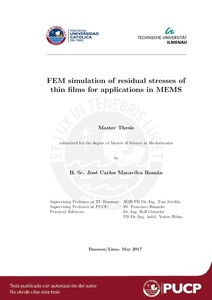| dc.contributor.advisor | Ströhla, Tom | |
| dc.contributor.advisor | Rumiche Zapata, Francisco Aurelio | |
| dc.contributor.author | Macavilca Román, José Carlos | es_ES |
| dc.date.accessioned | 2017-06-19T22:06:10Z | es_ES |
| dc.date.available | 2017-06-19T22:06:10Z | es_ES |
| dc.date.created | 2017 | es_ES |
| dc.date.issued | 2017-06-19 | es_ES |
| dc.identifier.uri | http://hdl.handle.net/20.500.12404/8831 | |
| dc.description.abstract | In MEMS sensors, such as resonators based on cantilever and doubly-clamped beams, the presence of residual stresses in the thin films disrupt their mechanical properties or eigenfrequencies and, in some cases, can destroy the structure. This thesis aims to simulate the residual stresses in wafers composed of thin films deposited over a substrate. The simulations were conducted with ANSYS Workbench R17.2, a finiteelement-method software. This work considered static simulations with a single-layer wafer geometry, since it is a first approach to the simulation of residual stresses. With the purpose of achieving
that, three simulation types were performed. Simulation 1 applied the thermal loads as heating and cooling steps to a quadrant model. Simulation 2 added the birth and death technique with the purpose of representing the deposition of the thin film. Besides, it was split under the geometric model as flat axisymmetric section, curved axisymmetric section, i.e. with the initial curvature of the wafer, and curved quadrant model. On the other hand, simulation 3 generated the residual stresses by the activation of the
contact between the thin film and the silicon dioxide layer, used as diffusive barrier. The simulation results were compared to calculated values from measurements performed by the methods of wafer curvature and X-ray diffraction. The comparison showed that the curved quadrant model allowed obtaining residual stresses and deflections closer to the calculated ones. In addition, the curved axisymmetric models allowed visualizing the residual stresses distribution in the layers and the substrate.
Thus, the birth and death technique was useful to simulate the deposition of the thin film. The considerations described in this work can be used as input data for more complex simulations based on MEMS structures | es_ES |
| dc.description.uri | Tesis | es_ES |
| dc.language.iso | eng | es_ES |
| dc.publisher | Pontificia Universidad Católica del Perú | es_ES |
| dc.rights | Atribución-NoComercial-SinDerivadas 2.5 Perú | * |
| dc.rights | info:eu-repo/semantics/openAccess | es_ES |
| dc.rights.uri | http://creativecommons.org/licenses/by-nc-nd/2.5/pe/ | * |
| dc.subject | Películas delgadas | es_ES |
| dc.subject | Sistemas microelectromecánicos | es_ES |
| dc.subject | Método de elementos finitos | es_ES |
| dc.title | FEM simulation of residual stresses of thin films for applications in MEMS | es_ES |
| dc.type | info:eu-repo/semantics/masterThesis | es_ES |
| thesis.degree.name | Magíster en Ingeniería Mecatrónica | es_ES |
| thesis.degree.level | Maestría | es_ES |
| thesis.degree.grantor | Pontificia Universidad Católica del Perú. Escuela de Posgrado | es_ES |
| thesis.degree.discipline | Ingeniería Mecatrónica | es_ES |
| renati.advisor.dni | 07833101 | |
| renati.discipline | 713167 | es_ES |
| renati.level | https://purl.org/pe-repo/renati/level#maestro | es_ES |
| renati.type | http://purl.org/pe-repo/renati/type#tesis | es_ES |
| dc.publisher.country | PE | es_ES |
| dc.subject.ocde | https://purl.org/pe-repo/ocde/ford#2.00.00 | es_ES |






